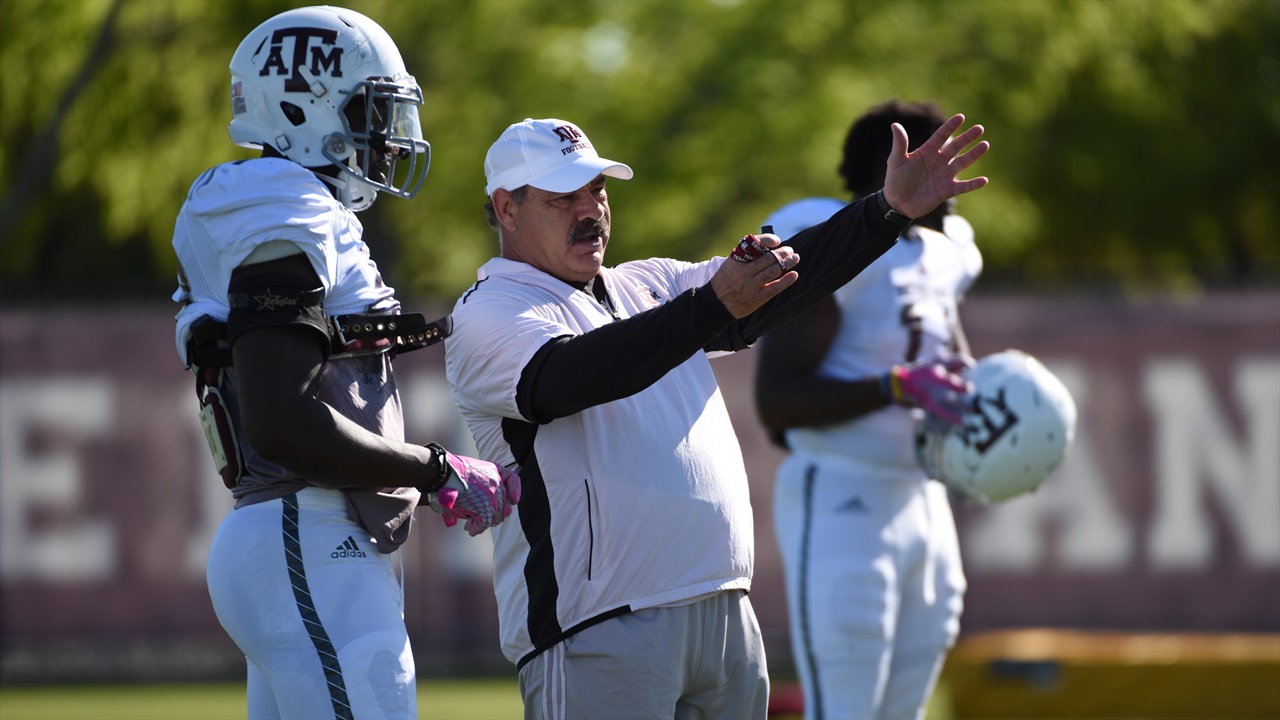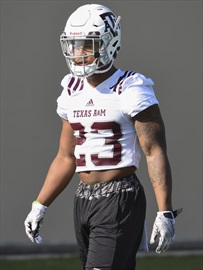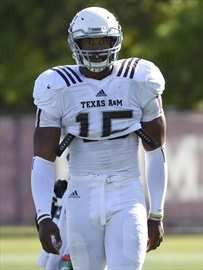
Photo by Lindsay Caudle, TexAgs
Texas A&M Football
The Climb: Why a top-15 leap isn't unreasonable for Aggies' defense
The climb is grueling. There are treacherous pitfalls. Very few have successfully completed it.
Rising from mediocrity to elite levels in total defense is — statistically — more difficult than scaling Mount Everest. Last season only one college football team climbed from the 50s in total defense into the nation’s top 15.
By comparison, 658 people climbed Everest. That’s according to the Himalayan database.
Yet last week Texas A&M coach Kevin Sumlin proclaimed the Aggies, who ranked just 51st in total defense last season, could field a top-15 defense in 2016.
Him a'lyin?
Maybe not.
Though difficult to climb from defensive mediocrity to in one year, it has been done.
In fact, Northwestern of the Big Ten did it last season.
Under the guidance of former Texas A&M defensive coordinator Mike Hankwitz, the Wildcats improved from 54th in the nation in 2014 to 13th last season.
Consequently, the Wildcats’ doubled their win production from five in 2014 to ten last season.
 Lindsay Caudle, TexAgs
Experience is finally on the Aggie defense's side, and the returning players with the most (Armani Watts pictured) are all-SEC candidates.
{"Module":"photo","Alignment":"left","Size":"large","Caption":"Experience is finally on the Aggie defense\u0027s side, and the returning players with the most (Armani Watts pictured) are all-SEC candidates.","MediaItemID":67468}
Therefore, the obvious question that Aggies would ask is: How did Northwestern make that climb?
Lindsay Caudle, TexAgs
Experience is finally on the Aggie defense's side, and the returning players with the most (Armani Watts pictured) are all-SEC candidates.
{"Module":"photo","Alignment":"left","Size":"large","Caption":"Experience is finally on the Aggie defense\u0027s side, and the returning players with the most (Armani Watts pictured) are all-SEC candidates.","MediaItemID":67468}
Therefore, the obvious question that Aggies would ask is: How did Northwestern make that climb?
“There was no magic elixir in Evanston,” said BTN.com Senior Writer Tom Dienhart. “There was nothing crazy, no new scheme or anything. They had decent personnel … a handful of NFL guys. It was just a maturation game.”
Other factors in Northwestern’s defensive improvement included health, defensive line depth and coaching stability.
Beside the fact that Northwestern started seven juniors or seniors on defense, the Wildcats also endured no significant injuries. They were good and deep up front, especially at end. Dean Lowry was a fourth-round draft pick of the Green Bay Packers. Deonte Gibson signed a free agent contract with the Detroit Lions.
The maturation process was especially evident in the secondary, where Northwestern started two seniors and a junior. Perhaps predictably, the Wildcats were ranked a healthy 23rd in the nation in pass defense last season.
A&M’s defense figures to be maturing as well. The Aggies could start as many as nine juniors and seniors next season. Five — juniors Armani Watts, Priest Willis, Nick Harvey and Donovan Wilson and senior Justin Evans — will be in the secondary. The Aggies were fourth in the nation in pass defense last season.
True, Harvey and Willis project as new starters at cornerback, so that could be a concern.
However, second-year defensive coordinator John Chavis said last spring he did not foresee any decline in production at that position.
Do you trust Chavis?
Also, like Northwestern, A&M will be strong at defensive end. In fact, the Aggies will be much stronger.
Northwestern is justifiably proud that Lowry was a fourth-round draft choice. But A&M’s Myles Garrett could be the first player selected in next year’s NFL Draft. ESPN’s Mel Kiper rates him as the top prospect.
Daeshon Hall is also projected as a high draft pick.
The Aggies will also be better, deeper and even more experienced than they’ve been on the defensive interior line than any season since joining the Southeastern Conference four years ago.
Think about it: Spencer Nealy played one season at tackle. So did Julien Obioha and Isaiah Golden. Kirby Ennis played one full season there. Alonzo Williams played two seasons at tackle, but was a converted defensive end.
 Lindsay Caudle, TexAgs
Texas A&M also features a deep and talented defensive line headlined by a potential future No. 1 overall pick.
{"Module":"photo","Alignment":"right","Size":"large","Caption":"Texas A\u0026M also features a deep and talented defensive line headlined by a potential future No. 1 overall pick.","MediaItemID":69909}
Sophomores Kingsley Keke and Daylon Mack already have as much playing experience as most of A&M’s previous SEC tackles. Junior Zaycoven Henderson has more playing experience at tackle than almost anyone else.
Lindsay Caudle, TexAgs
Texas A&M also features a deep and talented defensive line headlined by a potential future No. 1 overall pick.
{"Module":"photo","Alignment":"right","Size":"large","Caption":"Texas A\u0026M also features a deep and talented defensive line headlined by a potential future No. 1 overall pick.","MediaItemID":69909}
Sophomores Kingsley Keke and Daylon Mack already have as much playing experience as most of A&M’s previous SEC tackles. Junior Zaycoven Henderson has more playing experience at tackle than almost anyone else.
They’re all more talented, too. They were actually recruited as tackles, unlike most of their predecessors in the A&M line.
Another factor in Northwestern’s rise was the play of linebacker Anthony Walker, who developed into an All-Big Ten talent as a sophomore.
A&M has had poor linebacker play. However, the return of redshirt sophomore Otaro Alaka from injury figures to give the Aggies an immediate upgrade there.
If Alaka provides that boost, the defensive tackles emerge as expected, Garrett and Hall play to their ability and the secondary continues to develop, A&M’s defense could even be better than Northwestern. It had better be.
Despite all of Northwestern’s improvement the Wildcats were still thrashed in the Outback Bowl by Tennessee, 45-6.
A&M plays Tennessee on Oct. 8.
Obviously, the Aggies face a mountainous task to become an elite defense. But they appear equipped to make that climb.
Rising from mediocrity to elite levels in total defense is — statistically — more difficult than scaling Mount Everest. Last season only one college football team climbed from the 50s in total defense into the nation’s top 15.
By comparison, 658 people climbed Everest. That’s according to the Himalayan database.
Yet last week Texas A&M coach Kevin Sumlin proclaimed the Aggies, who ranked just 51st in total defense last season, could field a top-15 defense in 2016.
Him a'lyin?
Maybe not.
Though difficult to climb from defensive mediocrity to in one year, it has been done.
In fact, Northwestern of the Big Ten did it last season.
Under the guidance of former Texas A&M defensive coordinator Mike Hankwitz, the Wildcats improved from 54th in the nation in 2014 to 13th last season.
Consequently, the Wildcats’ doubled their win production from five in 2014 to ten last season.
 Lindsay Caudle, TexAgs
Experience is finally on the Aggie defense's side, and the returning players with the most (Armani Watts pictured) are all-SEC candidates.
{"Module":"photo","Alignment":"left","Size":"large","Caption":"Experience is finally on the Aggie defense\u0027s side, and the returning players with the most (Armani Watts pictured) are all-SEC candidates.","MediaItemID":67468}
Lindsay Caudle, TexAgs
Experience is finally on the Aggie defense's side, and the returning players with the most (Armani Watts pictured) are all-SEC candidates.
{"Module":"photo","Alignment":"left","Size":"large","Caption":"Experience is finally on the Aggie defense\u0027s side, and the returning players with the most (Armani Watts pictured) are all-SEC candidates.","MediaItemID":67468}
“There was no magic elixir in Evanston,” said BTN.com Senior Writer Tom Dienhart. “There was nothing crazy, no new scheme or anything. They had decent personnel … a handful of NFL guys. It was just a maturation game.”
Other factors in Northwestern’s defensive improvement included health, defensive line depth and coaching stability.
Beside the fact that Northwestern started seven juniors or seniors on defense, the Wildcats also endured no significant injuries. They were good and deep up front, especially at end. Dean Lowry was a fourth-round draft pick of the Green Bay Packers. Deonte Gibson signed a free agent contract with the Detroit Lions.
The maturation process was especially evident in the secondary, where Northwestern started two seniors and a junior. Perhaps predictably, the Wildcats were ranked a healthy 23rd in the nation in pass defense last season.
A&M’s defense figures to be maturing as well. The Aggies could start as many as nine juniors and seniors next season. Five — juniors Armani Watts, Priest Willis, Nick Harvey and Donovan Wilson and senior Justin Evans — will be in the secondary. The Aggies were fourth in the nation in pass defense last season.
True, Harvey and Willis project as new starters at cornerback, so that could be a concern.
However, second-year defensive coordinator John Chavis said last spring he did not foresee any decline in production at that position.
Do you trust Chavis?
Also, like Northwestern, A&M will be strong at defensive end. In fact, the Aggies will be much stronger.
Northwestern is justifiably proud that Lowry was a fourth-round draft choice. But A&M’s Myles Garrett could be the first player selected in next year’s NFL Draft. ESPN’s Mel Kiper rates him as the top prospect.
Daeshon Hall is also projected as a high draft pick.
The Aggies will also be better, deeper and even more experienced than they’ve been on the defensive interior line than any season since joining the Southeastern Conference four years ago.
Think about it: Spencer Nealy played one season at tackle. So did Julien Obioha and Isaiah Golden. Kirby Ennis played one full season there. Alonzo Williams played two seasons at tackle, but was a converted defensive end.
 Lindsay Caudle, TexAgs
Texas A&M also features a deep and talented defensive line headlined by a potential future No. 1 overall pick.
{"Module":"photo","Alignment":"right","Size":"large","Caption":"Texas A\u0026M also features a deep and talented defensive line headlined by a potential future No. 1 overall pick.","MediaItemID":69909}
Lindsay Caudle, TexAgs
Texas A&M also features a deep and talented defensive line headlined by a potential future No. 1 overall pick.
{"Module":"photo","Alignment":"right","Size":"large","Caption":"Texas A\u0026M also features a deep and talented defensive line headlined by a potential future No. 1 overall pick.","MediaItemID":69909}
They’re all more talented, too. They were actually recruited as tackles, unlike most of their predecessors in the A&M line.
Another factor in Northwestern’s rise was the play of linebacker Anthony Walker, who developed into an All-Big Ten talent as a sophomore.
A&M has had poor linebacker play. However, the return of redshirt sophomore Otaro Alaka from injury figures to give the Aggies an immediate upgrade there.
If Alaka provides that boost, the defensive tackles emerge as expected, Garrett and Hall play to their ability and the secondary continues to develop, A&M’s defense could even be better than Northwestern. It had better be.
Despite all of Northwestern’s improvement the Wildcats were still thrashed in the Outback Bowl by Tennessee, 45-6.
A&M plays Tennessee on Oct. 8.
Obviously, the Aggies face a mountainous task to become an elite defense. But they appear equipped to make that climb.
Never miss the latest news from TexAgs!
Join our free email list




